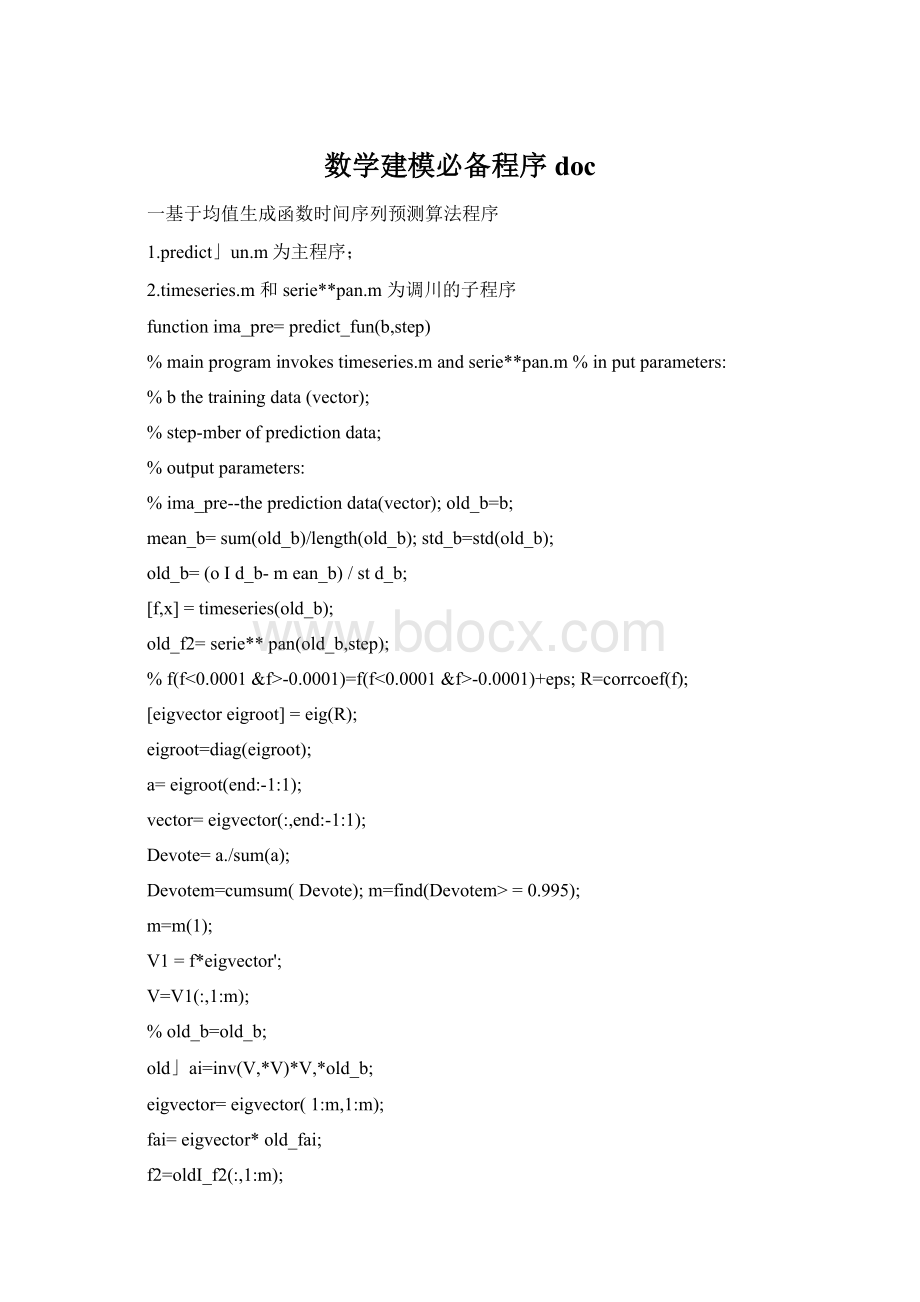数学建模必备程序doc.docx
《数学建模必备程序doc.docx》由会员分享,可在线阅读,更多相关《数学建模必备程序doc.docx(22页珍藏版)》请在冰豆网上搜索。

数学建模必备程序doc
一基于均值生成函数时间序列预测算法程序
1.predict」un.m为主程序;
2.timeseries.m和serie**pan.m为调川的子程序
functionima_pre=predict_fun(b,step)
%mainprograminvokestimeseries.mandserie**pan.m%inputparameters:
%bthetrainingdata(vector);
%step-mberofpredictiondata;
%outputparameters:
%ima_pre--thepredictiondata(vector);old_b=b;
mean_b=sum(old_b)/length(old_b);std_b=std(old_b);
old_b=(oId_b-mean_b)/std_b;
[f,x]=timeseries(old_b);
old_f2=serie**pan(old_b,step);
%f(f<0.0001&f>-0.0001)=f(f<0.0001&f>-0.0001)+eps;R=corrcoef(f);
[eigvectoreigroot]=eig(R);
eigroot=diag(eigroot);
a=eigroot(end:
-1:
1);
vector=eigvector(:
end:
-1:
1);
Devote=a./sum(a);
Devotem=cumsum(Devote);m=find(Devotem>=0.995);
m=m
(1);
V1=f*eigvector';
V=V1(:
1:
m);
%old_b=old_b;
old」ai=inv(V,*V)*V,*old_b;
eigvector=eigvector(1:
m,1:
m);
fai=eigvector*old_fai;
f2=oldI_f2(:
1:
m);
predictvalue=f2*fai;
ima_pre=std_b*predictvalue+mean_b;
1•子函数:
timeseries.m
%timeseriesprogram%
%thisprogramisusedtogeneratemeanvaluematrixf;
function[f,x]=timeseries(data)
%datatheinputsequenee(vector);
%f-meanvaluematrixf;
n=length(data);
forL=1:
n/2
nL=floor(n/L);
fori=1:
L
sum=0;
forj=1:
nLsum=sum+data(i+(j-1)*L);
end
x{L,i}=sum/nL;
end
end
L=n/2;
f=zeros(n3L);
fori=1:
L
rep=floor(n/i);
res=mod(n,i);
b=[x{i,1:
i}];b=b';
f(1:
rep*i,i)=repmat(b,rep,1);
ifres~=0
c=rep*i+1:
n;
f(rep*i+1:
end,i)=b(1:
length(c));
end
end
%serie**pan.m
%theprogramisusedtogeneratethepredictionmatrixf;functionf=serieipan(data,step);
%data-•-theinputsequenee(vector)
%setp-—thepredictionnumber;
n=length(data);
forL=1:
n/2
nL=floor(n/L);
fori=1:
L
sum=0;
forj=1:
nLsum=sum+data(i+(j-1)*L);
end
x{L,i}=sum/nL;
end
end
L=n/2;
f=zeros(n+step丄);
fori=1:
L
rep=floor((n+step)/i);
res=mod(n+step3i);
b=[x{i,1:
i}];b=b,;
f(1:
rep*ij)=repmat(b,rep,1);
ifres~=0
c=rep*i+1:
n+step;
f(rep*i+1:
end,i)=b(1:
length(c));
end
end
二最短路Dijkstra算法
%dijkstraalgorithmcodeprogram%
%theshortestpathlengthalgorithm
function[path,short_distanee]=ShortF^th_Dijkstra(Input_weight,start,endpoint)
%Inputparameters:
%Input_weighttheinputnodeweight!
%startthestartnodenumber;
%endpointtheendnodenumber;
%Outputparameters:
%paththeshortestlenghtpathfromthestartnodetoendnode;
%short_distance・……thedistaneeoftheshortestlenghtpathfromthe
%startnodetoendnode.
[row,col]=size(lnput_weight);
%inputdetection
ifrow~=col
error(1nputmatrixisnotasquarematrix,inputerror1);
end
ifendpoint>row
error(*inputparameterendpointexceedthemaximalpointnumberf);
end
%initialization
s_path=[start];
distance=inf*ones(1,row);distance(start)=O;
flag(start)=start;temp=start;
whilelength(s_path)vrow
pos=find(lnput_weight(temp,:
)~=inf);
fori=1:
length(pos)
if(length(find(s_path==pos(i)))==0)&
(distance(pos(i))>(distance(temp)+lnput_weight(temp,pos(i))))
distance(pos(i))=distance(temp)+lnput_weight(temp,pos(i));
什ag(pos(i))=temp;
end
end
k=inf;
fori=1:
row
if(length(find(s_path==i))==O)&(k>distance(i))k=distance(i);
temp_2=i;
end
end
s_path=[s_path,temp_2];
temp=temp_2;
end
%outputtheresult
path
(1)=endpoint;
i=1;
whilepath(i)^=start
path(i+1)=flag(path(i));
i=i+1;
end
path(i)=start;
path=path(end>1:
1);
shortdistance=distance(endpoint);
三绘制差分方程的映射分叉图
functionfork1(a);
%绘制x_(n+1)=1-a*xA2_n映射的分叉图
%Example:
%fork1([0,2]);
N=300;%取样点数
A=linspace(a
(1),a
(2),N);
starx=0.9;
Z=[];
h=waitbar(O,'pleasewaitf);m=1;
forap=A;
x=starx;
fork=1:
50;
x=1-ap*xA2;
end
fork=1:
201;
x=1-ap*xA2;
Z=[Z,ap-x*i];
end
waitbar(m/N,h,['completed',num2str(round(100*m/N)),*%']^);
m=m+1;
end
delete(h);
plot(Z;.\,markersize\2)
xlim(a);
四最短路算法——floyd算法
functionShortF^th_floyd(w,start,terminal)
%w-—adjoinmatrix,w=[050infinfinf;inf0infinf80;
%inf30020inf;infinfinf070;65inf100inf0];
%startthestartnode;
%terminal-theendnode;
n=size(w,1);
[D,path]=floyd1(w);%调用floyd算法程序
%找出任意两点之间的最短路径,并输出
fori=1:
n
forj=1:
n
MinjDath(iJ).distance=D(i,j);
%将匚到j的最短路程赋值Min_path(i,j).distance
%将i至I」j所经路径赋给Min_path(i,j).path
MinjDath(i,j).path
(1)=i;
k=1;
whileMin_path(i,j).path(k)~=j
k=k+1;
Min_path(i,j).path(k)=path(Min_path(i,j).path(k-1),j);
end
end
end
s=sprintf('任意两点之间的最短路径如下:
’);
disp(s);
fori=1:
n
forj=1:
n
s=sprintf('从%d到%(1的最短路径长度为:
%d\n所经路径为:
J,j5Min_path(iJ).distanee);
disp(s);
disp(Min_path(i,j).path);
end
end
%找出在指定从start点到terminal点的最短路径,并输出
str1=sprintf(%%d到%(1的最短路径长度为:
%d\n所经路径为:
',…start,terminal,Min_path(start,terminal).distanee);
disp(strl);
disp(MinjDath(start,terminal).path);
%Foldy'sAlgorithm算法程序function[D,path]=floyd1(a)n=size(a,1);
D=a;path=zeros(n,n);%设置D和path的初值fori=1:
n
forj=1:
n
ifD(i,j)~=inf
path(i,j)=j;%j是i的后点
end
end
end
%做n次迭代,每次迭代都更新D(i,j)和path(i,j)fork=1:
n
fori=1:
n
forj=1:
n
ifD(i,k)+D(k,j)vD(i,j)D(i,j)=D(i,k)+D(k,j);%修改长度path(i,j)=path(i,k);%修改路径end
end
end
end
五模拟退火算法源程序
function[MinD,BestF^th]=MainAneal(QtyRosition3pn)
function[MinD,BestF^th]=MainAneal2(QtyFbsition,pn)
%此题以屮国31省会城市的最短旅行路径为例,给出TSP问题的模拟退火程序
%QtyFbsition_31=[13042312;36391315;41772244;37121399;3488
1556;..・
%
1756;...
%
2370;...
%
2376;...
%
2826;23702975];
1535;3326
3238
2788
3780
3394
1229;4196
1044;4312
790;4386
570;3007
1970;2562
1491;2381
1676;1332
695;3715
1678;3918
2179;4061
2212;3676
2578;4029
2838;4263
2931;3429
1908;3507
2643;3439
3201;2935
3240;3140
3550;2545
2357;2778
%T0=clock
globalpathp2D;
[m,n]=size(QtyFbsition);
%牛成初始解空间,这样可以比逐步分配空间运行快i些
TraceF^th=zeros(1e3,m);
Distance=inf*zeros(1,1e3);
D=sqrt((QtyFbsition(:
ones(1,m))-OtyFbsition(:
ones(1,m))').A2+...(QtyFbsition(:
2*ones(1,m))・QtyFbsition(:
2*ones(1,m))*).A2);
%将城市的坐标矩阵转换为邻接矩阵(城市间距离矩阵)
fori=1:
pn
path(i,:
)=randperm(m);%构造一个初始可行解
end
t=zeros(1,pn);
p2=zeros(1,m);
iter_max=100;%input('ih输入固定温度下最人迭代次数iter_max=*);m_max=5;%inputC请输入El定温度下日标函数值允许的最大连续未改进次数m_nax=*);
%如果考虑到降温初期新解被吸收概率较人,容易陷入局部最优
%而随着降温的进行新解被吸收的概率逐渐减少,乂难以跳出局限
%人为的使初期iter_max,m_max较小,然后使Z随温度降低而逐步增大,可能
%会收到到比较好的效果
T=1e5;
N=1;
tau=1e-5;%input(*iR输入最低温度tau=');
%nn=ceil(log10(tau/T)/log10(0.9));
whileT>=tau%&m_numvm_max
iter_num=1;%某固定温度下迭代计数器m_num=1;%某固定温度下目标函数值连续未改进次数计算器%iter_max=100;
%m_max=10;%ceil(10+0.5*nn-0.3*N);
whilem_num%MRF0T(Metropolis,Rosenbluth,Rosenbluth,Teller,Teller)过程:
%川任意启发式算法在path的领域叫path)中找出新的更优解
fori=1:
pn
Len1(i)=sum([D(path(i,1:
m-1)+m*(path(i,2:
m)-1))D(path(i,m)+m*(path(i,1)-1))]);
%计算一次行遍所有城市的总路程
[path2(i,:
)]=ChangePath2(path(i,:
),m);%更新路线
Len2(i)=sum([D(path2(i,1:
m-1)+m*(path2(i,2:
m)-1))D(path2(i,m)+m*(path2(i,1)-1))]);
end
%Len1
%Len2
%ifLenyLenlAo-exp((LenrLen2)、(T))Vrand
R=rand?
pn)_
%Len2,Len1A二exp((LenrLen2)二T))VRiffind((Len2,Lerdci-exp((LenrLen2)、(T))vRTHO)path(find((Len2-LerdAi-exp((LenrLen2)、(T))VR)〜H0L二Hpaih2(find((Len2,Lenlci_ex
p((Len「Len2)、(T}vR);0r)_
Lenl(find((Len2,LerHct_exp((LenrLen2LenrLen2)、(T))VR)〜H0))八
(TempMinpRmp-ndex」nmin(Lerd)-
%TempMinD
TraceF^ihz..Tpaih(Temp-ndex..「
Disiance(N..TTempMinp
NHN++
%TUT69
m—numHp
e-se
m—numHm—num+Jt
end
iiernumHiiernum+t
end
THT69%m—nummer—num>end
【MinDJndex」nmin(Distance)八BesiF^hHTracepaihundex..)八disp(MinD)
%Tfc-ock
%M連察function(p2Tchangepa52(plQiyNum)
g-oba-p2;
whi-e(l)
RHunidmd(CKyNum=2)八
ifabs(R(vR
(2))vl
break」
end
R==unidmd(cityNum・12)-
I=R
(1);J=R
(2);
%len1=D(p(l),p(J))+D(p(l+1),p(J+1));
%len2=D(p(l),p(l+1))+D(p(J),p(J+1));
iflp2(1:
l)=p1(1:
l);
p2(l+1:
J)=p1(J:
-1:
l+1);
p2(J+1:
QtyNum)=p1(J+1:
QtyNum);
else
p2(1:
J)=p1(1:
J);
p2(J+1:
l)=p1(l:
-1:
J+1);
p2(l+1:
QtyNum)=p1(l+1:
QtyNum);
end
六遗传算
法程序:
说明:
为遗传算法的主程序;采用二进制&ay编码,采用基于轮盘赌法的非线性排名
选择,均匀交义,变异操作,而且还引入了倒位操作!
function
[BestFbp?
Trace]=fga(FUN,LB,UB,eranum,popsize,pCross,pMutation,plnversion,options)
%[BestFbp,Trace]=fmaxga(FUN,LB,UB,eranum5popsize,pcross,pmutation)
%Findsamaximumofafunctionofseveralvariables.
%fmaxgasolvesproblemsoftheform:
%
maxF(X)
subjectto:
l_B<=X<=UB
%
BestFtp
・最优的群体即为授优的染色体群
%
Trace
・最佳染色体所对应的口标惭数值
%
FUN
・目标函数
%
LB
・自变量下限
%
UB
・自变量上限
%
eranum
-种群的代数,JR100-1000(默认200)
%
popsize
・每一•代种群的规模;此可取50-200(默认100)
%
pcross
・交义概率,一般取0.5-0.85之间较好(默认0.8)
%
pmutation
-初始变异概率,一般取0.05-0.2Z间较好(默认0.1)
%
pinversion
•倒位概率,一般取0.05—0.3Z间较好(默认0.2)
%
options
-T2矩阵‘options⑴=0二进制编码(默认0),option⑴~=0十进制编
%码,option
(2)设定求解精度(默认1e-4)
%
%
T1=clock;
ifnargin<3,error(fFMAXGArequiresatleastthreeinputarguments');end
ifnargin==3,
eranum=200;popsize=100;pCross=0.8;pMutation=0.1;plnversion=0.15;options=[01e-4];end
ifnargin==4,popsize=100;pCross=0.8;pMutation=0.1;plnversion=0.15;options=[0
1e-4];end
ifnargin==5,pCross=0.8;pMutation=0.1;plnversion=0.15;options=[01e-4];end
ifnargin==6,pMutation=0.1;plnversion=0.15;options=[01e-4];end
ifnargin==7,pinversion=0.15;options=[01e-4];end
iffind((l_B-UB)>0)
errorC数据输入错误,请重新输入(l_B*);
end
s=sprin廿('程序运行需要约%.4f秒钟时间,请稍等……',(eranum*popsize/1000));
disp(s);
globalmnNewFbpchildren1children2VarNum
bounds=[LB;UB]f;bits=[];VarNum=size(bounds,1);precision=options
(2);%dL]求解精度确定二进制编码长度bits=ceil(log2((bounds(:
2)-bounds(:
1))*./precision));%由设定精度划分区间[Fbp]=InitFbpGray(popsize,bits);%初始化种群
[m,n]=size(Fbp);
NewFtop=zeros(m,n);
children1=zeros(15n);
children2=zeros(1,n);
pmO=pMutation;
BestFbp=zeros(eranum,n);%分配初始解空间BestFbp,Trace
Trace=zeros(eranumjength(bits)+1);
i=1;
whilei<=eranum